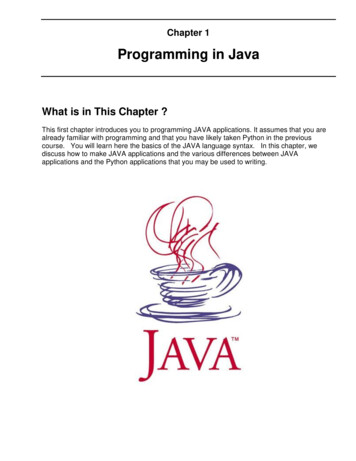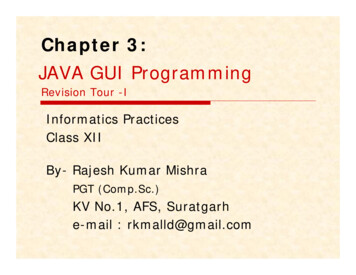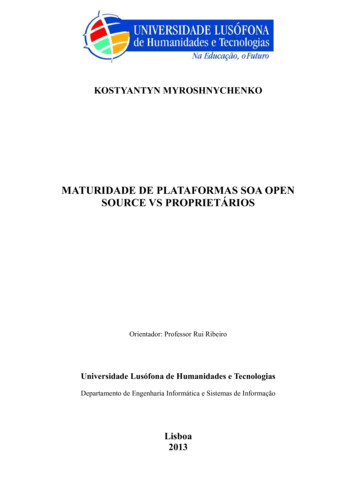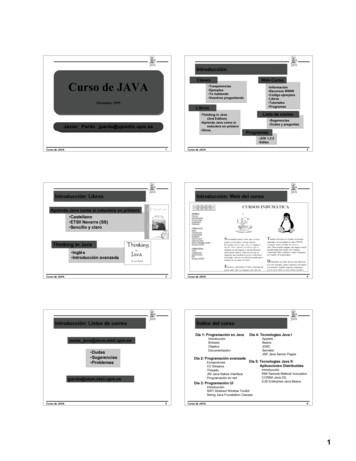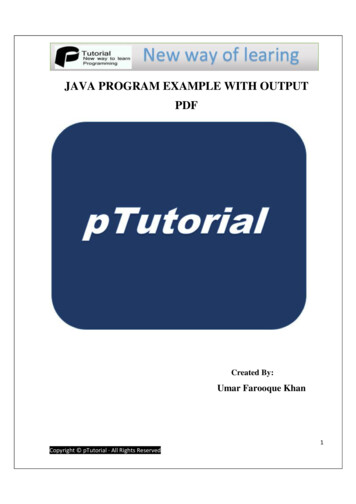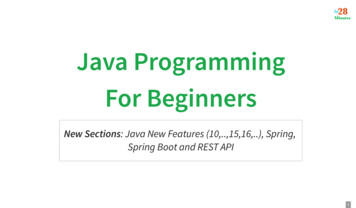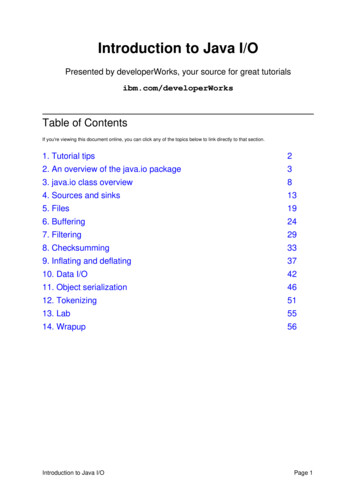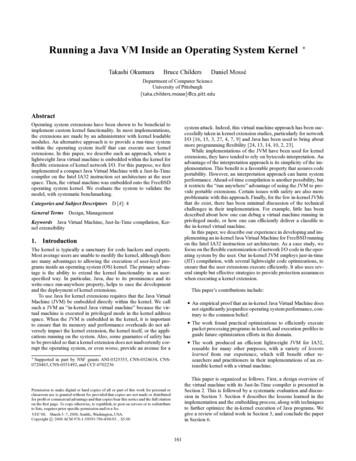
Transcription
Running a Java VM Inside an Operating System KernelTakashi OkumuraBruce Childers Daniel MosséDepartment of Computer ScienceUniversity of tOperating system extensions have been shown to be beneficial toimplement custom kernel functionality. In most implementations,the extensions are made by an administrator with kernel loadablemodules. An alternative approach is to provide a run-time systemwithin the operating system itself that can execute user kernelextensions. In this paper, we describe such an approach, where alightweight Java virtual machine is embedded within the kernel forflexible extension of kernel network I/O. For this purpose, we firstimplemented a compact Java Virtual Machine with a Just-In-Timecompiler on the Intel IA32 instruction set architecture at the userspace. Then, the virtual machine was embedded onto the FreeBSDoperating system kernel. We evaluate the system to validate themodel, with systematic benchmarking.system attack. Indeed, this virtual machine approach has been successfully taken in kernel extension studies, particularly for networkI/O [16, 15, 3, 27, 4, 7, 9] and Java has been used to bring aboutmore programming flexibility [24, 13, 14, 10, 2, 23].While implementations of the JVM have been used for kernelextensions, they have tended to rely on bytecode interpretation. Anadvantage of the interpretation approach is its simplicity of the implementation. This benefit is a favorable property that assures codeportability. However, an interpretation approach can harm systemperformance. Ahead-of-time compilation is another possibility, butit restricts the “run anywhere” advantage of using the JVM to provide portable extensions. Certain issues with safety are also moreproblematic with this approach. Finally, for the few in-kernel JVMsthat do exist, there has been minimal discussion of the technicalchallenges in their implementation. For example, little has beendescribed about how one can debug a virtual machine running inprivileged mode, or how one can efficiently deliver a classfile tothe in-kernel virtual machine.In this paper, we describe our experience in developing and implementing an in-kernel Java Virtual Machine for FreeBSD runningon the Intel IA32 instruction set architecture. As a case study, wefocus on the flexible customization of network I/O code in the operating system by the user. Our in-kernel JVM employs just-in-time(JIT) compilation, with several lightweight code optimizations, toensure that the user extensions execute efficiently. It also uses several simple but effective strategies to provide protection assuranceswhen executing a kernel extension.Categories and Subject Descriptors D [4]: 4General Terms Design, ManagementKeywords Java Virtual Machine, Just-In-Time compilation, Kernel extensibility1. IntroductionThe kernel is typically a sanctuary for code hackers and experts.Most average users are unable to modify the kernel, although thereare many advantages to allowing the execution of user-level programs inside an operating system (OS) kernel. The primary advantage is the ability to extend the kernel functionality in an userspecified way. In particular, Java, due to its prominence and itswrite-once run-anywhere property, helps to ease the developmentand the deployment of kernel extensions.To use Java for kernel extensions requires that the Java VirtualMachine (JVM) be embedded directly within the kernel. We callsuch a JVM an “in-kernel Java virtual machine” because the virtual machine is executed in privileged mode in the kernel addressspace. When the JVM is embedded in the kernel, it is importantto ensure that its memory and performance overheads do not adversely impact the kernel extension, the kernel itself, or the applications running on the system. Also, some guarantee of safety hasto be provided so that a kernel extension does not inadvertently corrupt the operating system, or even worse, provide an avenue for aThis paper’s contributions include: An empirical proof that an in-kernel Java Virtual Machine doesnot significantly jeopardize operating system performance, contrary to the common belief. The work found practical optimizations to efficiently executepacket processing programs in kernel, and execution profiles toguide future optimization efforts in this domain. The work produced an efficient lightweight JVM for IA32,in part by NSF grants ANI-0325353, CNS-0524634, CNS0720483, CNS-0551492, and CCF-0702236reusable for many other purposes, with a variety of lessonslearned from our experience, which will benefit other researchers and practitioners in their implementations of an extensible kernel with a virtual machine.Permission to make digital or hard copies of all or part of this work for personal orclassroom use is granted without fee provided that copies are not made or distributedfor profit or commercial advantage and that copies bear this notice and the full citationon the first page. To copy otherwise, to republish, to post on servers or to redistributeto lists, requires prior specific permission and/or a fee.VEE’08, March 5–7, 2008, Seattle, Washington, USA.Copyright c 2008 ACM 978-1-59593-796-4/08/03. . . 5.00This paper is organized as follows. First, a design overview ofthe virtual machine with its Just-In-Time compiler is presented inSection 2. This is followed by a systematic evaluation and discussion in Section 3. Section 4 describes the lessons learned in theimplementation and the embedding process, along with techniquesto further optimize the in-kernel execution of Java programs. Wegive a review of related work in Section 5, and conclude the paperin Section 6. Supported161
ionstdoutstdinVIF1VIFletenqueue()VIFNetwork interfacePacketsFigure 1. Overview of the in-kernel lightweight JVM2. Design of the VM/JITpublic class PriQ VIFlet extends VIFlet {private static final int NCLASS 4;private Queue[] queue;private PacketClassifier pc new SimplePacketClassifier();2.1 Background and OverviewWe have developed a new control model of network I/O in which aneveryday user and application programs can safely control networkI/O without system administrator privileges. Our approach relies ona novel virtualization model, called hierarchical virtualization ofnetwork interfaces [18]. The model transforms network interfacesinto a hierarchical structure of virtual interfaces (VIF) and connectsthe VIFs into terminating entities, such as processes, threads, andsockets (Figure 1-left). This simple model accomplishes partitioning of the physical resource and provides isolation of administrativedomains among users and applications at a desired granularity. It isalso not limited just to a single interface or to the entire system. Forexample, in the figure, control made on VIF1 affects only traffic forprocess P1. If finer granularity of control is needed, P1 may simplyuse VIF11 or VIF12 to control the traffic for sockets S1 and S2,respectively, without affecting traffic for P2 and P3.PriQ VIFlet() {System.out.println("Initializing.");queue new Queue[NCLASS];for (int i 0; i NCLASS; i )queue[i] new Queue();}public void enqueue(Packet p) {int type pc.classify(p);length ;queue[type % NCLASS].enqueue(p);}public Packet dequeue() {for (int i 0; i NCLASS; i )if (queue[i].isEmpty() ! true) {length--;return queue[i].dequeue();}return null;}Because the virtualization model provides isolation of traffic, itis a powerful framework for allowing custom packet processing.Accordingly, we designed a programming model, called a VIFlet,which allows the injection of packet processing code into the kernel without system-wide administrator privileges (Figure 1-right).A VIFlet is a Java-based software component that includes packetprocessing event-handlers. A user and his/her applications can inject a VIFlet into each VIF they control to create a customized behavior for packet processing.When a packet arrives at the VIF, the system invokes eventhandlers to appropriately process packets and move the packets tothe next stage of processing, namely enqueue() and dequeue()in the figure. In our VIFlet model, these are two Java methods inthe VIFlet class. Users are allowed (encouraged) to override thesemethods to specify what should be done when a packet arrives(enqueue) and when a packet should be sent to the next VIF or tothe user entity (dequeue). Because the VIFlets are written in Java,even a novice programmer can write his/her own packet processingcode, and thus benefit from this kernel extension mechanism.A sample code of the programming model is shown in Figure 2 to illustrate the actual use of VIFlets by processing packets according to some priority rules, rather than FIFO order. First,}Figure 2. Sample VIFlet codewe declare a VIFlet by inheriting the VIFlet class. The example,PriQ VIFlet, is a VIFlet that does simple priority queuing. In theconstructor, we initialize Queue objects, which keep actual packets. The methods enqueue() and dequeue() are event handlersfor packet handling and packet processing. These are invoked whentheir associated events occur: packet arrival and packet drainage.The example VIFlet classifies incoming packets through theSimplePacketClassifier class (not shown), and queues packetsbased on the packet type returned by the packet classifier. Althoughthe VIFlet model is a simple concept, this example illustrates thatthe model has enough descriptive power to realize queuing controls. It is easy to see that VIFlet can also perform packet filtering,by selectively dropping packets.162
OPTOPTOPTOPTOPTOPTOPTOPTOPTOPTTo empirically verify the feasibility of the proposed scheme, andto see if Java programs can perform the packet processing task atpractical performance inside the OS kernel, we implemented an inkernel Java Virtual Machine (called NVM), with an associated justin-time compiler (called NYA). Our prototype was implemented asan extension to the VIF framework [18], which is an open sourcesystem developed for the BSD and Linux operating systems. Userinterface of the system is provided through the /proc file systemabstraction. VIFs are represented as a hierarchical directory structure under /proc/network/. In our prototype, users put a VIFlet(a VIFlet classfile or archived classfiles) into a VIF directory withappropriate write permissions. Once inserted in the directory, theVIF is immediately and automatically injected into the kernel, dueto /proc and VIF structures. Output from the in-kernel JVM orVIFlet are sent to a log file in the same directory of the VIFlet. Relying on the /proc file system has the advantage of little overheadand all in-memory NLININGNULLIFYINLINECLKFASTINVMCACHERegister cache of localsInstruction foldingFurther instruction foldingEnables array object cacheEnables fast object accessInlines small functionsNullifies void functionsInlines clock syscallInvokes methods fastEnables method cacheTable 1. Optimization Options OPT COMBINEOP performs instruction folding, which gener-ates simpler instructions for idiomatic sets of successive bytecodes, such as arithmetic operations on the stack OPT COMBINELD attempts further instruction folding onbytecode, spanning more than two instructions2.2 NVM: A lightweight Java VM OPT ACACHE boosts the access to array objects by simpleVIFlets are processed in the kernel via a Java Virtual Machine. Toallow integration with the kernel, the virtual machine implementation needs to be kept modular and compact. NVM is one suchlightweight JVM that was designed to be embedded in the OS kernel. It is based on Waba VM [25], which is a simplified Java interpreter that targets small computing devices. Waba VM’s sourcecode is open to the public and its simplified interpreter engine ishighly portable to various architectures.To serve as an in-kernel JVM, we needed to heavily modifythe Waba VM for three reasons. First, the interpreter was tooslow because it interprets each instruction one by one. Second,Waba requires an independent class library file. For an in-kernelVM, a more appropriate solution is to integrate the VM and thelibrary class file to simplify the implementation. Lastly, Waba’sclass loader takes just a simple class file as input; it can not read aJava archive (JAR) file. To avoid excess interaction between kernelspace and user space, the class loader must be more sophisticated.For these reasons, we modified the original Waba VM andimplemented various components and tools. NYA, outlined in thenext subsection, is a Just-In-Time compiler designed for the virtualmachine. The class library was highly tuned for in-kernel executionof packet processing code (e.g., eliminating RMI). Furthermore,the class loader was rewritten, with a decoder for JAR files and forbuilt-in classes.caching OPT OBJECT achieves faster access to objects by optimizingaddress expressions OPT INLINING inlines small methods, which eliminates invo-cation overhead for these methods OPT NULLIFY eliminates invocation of void methods OPT INLINECLK is an option to boost the access to systemclock, which is often used in packet processing OPT FASTINV boosts method invocation; this is done becauseusually method invocation of an object oriented language isa complex task, which requires runtime determination of theactual callee OPT MCACHE boosts the method call by simple caching2.4 Customization for PerformanceThe options described above are optimizations to execute Java programs faster, in general. To further boost the execution of packetprocessing programs, customizations are made to the virtual machine by removing unused features and adding useful native routines. This implies that NVM supports a subset of Java – ratherthan the entire Java specification. Although these changes violatethe standard rules for creating a JVM, our approach is similar to theone used for specialized Java execution environments. For example, Java 2 Micro Edition (J2ME) specified the K Virtual Machine,which is designed for embedded systems with limited memory andprocessing power [22]. The difference is that we specialized theJVM for packet processing. The changes made include:2.3 NYA: A Just-In-Time compiler for NVMAlthough NVM can execute VIFlet programs as well as ordinaryJava class files, as mentioned above, interpretation is not a practicalsolution to execute Java programs in the kernel. NYA is a Just-InTime (JIT) compiler, developed to boost the execution performanceof NVM.Because each VM has its own memory model, a JIT must bedesigned for each VM and written almost from scratch. For example, the internal representation of a class greatly differs from VMto VM, and object instances are represented differently in memory.For this reason, NYA is developed specifically for NVM, reusingthe bytecode management framework of TYA [12], which is anopen source JIT for the Sun Classic VM on the IA32 architecture.NYA performs simple table-driven translation of a bytecodeinto native instructions. Accordingly, the next challenge was howto further boost the performance with code optimization. To thisend, various optimizations were added, as shown in Table 1, anddescribed below. Because most variables for packet processing do not require 64bits, 64-bit variables such as long and double are substitutedby 32-bit int and float. This change greatly simplifies the VMdesign on a 32-bit architecture. We eliminated Java constructs that are not typically useful forpacking processing with VIFlets, including Exception, Thread,and Monitor. The JVM simply aborts a VIFlet when it findssuch operations, as a security violation. Users are expected toassure code integrity and avoid the use of these constructs. We removed code verification to speed up JVM processing andreduce response time. Indeed, NVM does not perform code verification before execution. Rather, we guarantee system securityby aborting execution of a VIFlet when an illegal instruction isexecuted. OPT REGCACHE caches frequently used local variables onthe registers163
We provided native functions for routine processing, such aschecksumming. This is because it would still be costly forJava programs to intensively access the packet payload, whichrequires checking of the addresses legitimacy in each step ofthe payload access. Since we want to enhance the performanceof packet processing, it is important to optimize data access tothe packet payload.3500Sieve Benchmark (Score)3000These customizations not only improved the execution performance, they also had a favorable impact on the code size of thevirtual machine and JIT. The resultant virtual machine (NVM) isjust 64KB in size, including its class library. The size of the Sunclassic JVM for the same architecture is 981KB and it also requiresa standard class library file of 8907KB (JDK1.1.8). Additionally,the NYA JIT is only 64KB in size. For comparison, the size of theJIT compilers TYA and shuJIT, which are used in our performanceevaluation, are 84K and 132K, respectively. Despite these changes,NVM does support standard Java mechanisms such as inheritanceand interfaces. It can run ordinary Java bytecode generated by ordinary Java compilers, without any NYAsieve.cFigure 3. Sieve Benchmarkputing platform with the following specifications. Hardware: IntelCeleron 2.0Ghz CPU, Gigabyte GA-8INXP motherboard (Chipset:E7205), and 512MB of main memory. Software: FreeBSD 4.11and JDK1.1.8.2.5 Protection mechanismsBecause VIFlets allow any user to write software code that canbe executed in the kernel, the NVM/NYA needs protection mechanisms to assure the isolation of code execution. It is possible that amalicious or careless programmer could create a VIFlet with an infinite loop, where each iteration of the loop invokes many methodsor does some heavy computation. To ensure resource protection,we implemented two mechanisms, in addition to the hierarchicalvirtualization framework for code isolation.First, a stack depth counter is implemented to abort a VIFletwhen the run-time stack exceeds a certain threshold. For this purpose, the system keeps a global variable which is decremented atmethod call, and incremented at method return. Utilizing the simplemechanism, a VIFlet that inadvertently makes too many recursivecalls will be aborted, when the stack depth exceeds the threshold.Note that the JIT uses the kernel stack to hold the Java stack. Thisarrangement has simple and fast address calculations.Second, a software timer is used to abort a VIFlet’s executionwhen a time threshold is exceeded. To implement the timer, weinstrumented the code at special locations, adding a counter (say,of number of instructions executed). The JIT emits instructionsnecessary to keep track of the number of backward branches takenin a method. Whenever a backward branch is taken, the counteris decremented to check if the value is still positive. When thecounter reaches zero, the in-kernel JVM invokes an abort routineto terminate the execution of the program.Because NVM/NYA does not perform code verification, a malicious user may inject Java classes with bogus bytecodes. Such bytecodes could cause the program to execute in an unexpected manner. However, the effect of this action is strictly limited to the Javaheap because the system restricts accesses to stay within the Javaenvironment. The code is gracefully terminated by the protectionmechanisms when execution exceeds the given limits, or executesan unsupported bytecode, affecting solely that user’s packets. Anexpensive alternative to this “reactive” approach is to implement averifier that has to be used prior to running a VIFlet.Raw Performance Benchmark We first executed the Sieve benchmark, a widely available CPU-intensive benchmark for performance evaluation of Java platforms. It is a simple benchmark thatiteratively performs the Eratosthenes’ prime number sieve algorithm. It shows the number of iterations in a period as a Sievescore. We used this benchmark to compare our implementationwith other JVMs and JITs. The measurements in Figure 3 are takenin user space, unless otherwise noted. We did not use the timer protection feature (loop detection) because it would quickly terminatethe benchmark with a timing violation.The lowest performance was by NVM, i.e., our interpretedvirtual machine. The Sun classic JVM interpreter (labeled “JVM”),bundled with JDK1.1.8 performed 2.4 times faster than NVM. TYAand shuJIT are open source JITs for the Sun JVM, and they boostedthe performance of the Sieve benchmark by five times over Sun’sJVM. Our JIT, NYA, had equivalently good performance as shuJIT,exhibiting a substantial improvement over the NVM interpreter.To investigate in-kernel execution of NVM, we measured itsperformance on the Sieve benchmark when hosted inside the kernel. The result is shown in the figure by the bar labeled “k-NYA”.As shown, there was a 10% increase in the Sieve score, which isthe best performance among all the JITs in the figure. The improvement is due to the non-preemptive property of in-kernel executionof the JVM.Finally, we measured the performance of the Sieve benchmarkas a native program written in C. The Sieve score for this program isshown by the bar labeled sieve.c in the figure. It is noteworthy thatk-NYA is within 91% of the native C performance and is 11 timesfaster than the interpreter. This result shows that the virtualizedcode need not significantly jeopardize system performance.Object handling benchmark The Object sort benchmark checksperformance of object handling and array access by creating, sorting, and checking object arrays. The results in Figure 4 are normalized to the NVM interpreter, which had the lowest performance.The Sun JVM’s performance was close to the interpreted NVM.TYA and shuJIT performed three times better than NVM. NYAwith optimizations outperformed the other JITs by 100% and NVMby a factor of 6. This gain is ascribed to the optimizations appliedby NYA, such as object caching.In this study, no counterpart was provided for the native codebecause there are no objects in C and it is hard to make a fair3. Evaluation and DiscussionThis section presents the performance profile of the NVM and NYAimplementations. We also discuss future improvements.3.1 Basic Performance ProfileWe executed several benchmarks to profile the prototype implementation. For the experiments, we utilized an experimental com-164
87Object Sort Benchmark6543210NVMJVMSHUTYANYAFigure 4. Object Sort Benchmark (normalized to NVM)Figure 6. VIFlet Performance (Throughput)comparison. This situation is in contrast with the Sieve benchmark,where we can run almost identical programs in C and in Java.Benchmarking a VIFlet To measure performance of the VIFletsystem, we first measured the throughput of a simple VIFlet, whichjust relays packets. For this purpose, we generated a TCP streamfrom a VIFlet machine to another machine, measuring the throughput at the receiving end. On the VIFlet machine, we configured it sothat the measured traffic goes through just one VIF, virtualizing theGbE interface. We ran the traffic generator for 10 seconds, and usedthe best 1 second interval as a peak throughput for further analysis.The results are shown in Figure 6, where “simple” refers to aVIFlet that intercepts and forwards (no extra processing) both outgoing and incoming packets, “single” is a VIFlet that controls onlyoutgoing traffic, “VIF framework” denotes throughput of the system without running any VIFlet (i.e., just running the VIF system),“Bypass” is when the VIF system is bypassed, and “PriQ” is a VIFlet that performs priority queuing.From Figure 6 we observe the following for each VIFlet. Simple: the VIFlet framework has very little overhead, just a fewpercent overhead of the maximum throughput. Single: there is aslight performance increase, compared with Simple, by omittingthe methods for incoming packets; this is because latency for thepacket processing was bounding TCP. VIF framework: has almostno performance penalty. PriQ: just a 7% overhead suggests that avirtualized code can be a practical solution.Performance Breakdown In this study, we measured executiontime to perform primitive operations of Java bytecode, such asmethod invocation, array access, ALU, object creation, etc. Because we have already described the performance of the classicJVM, we did not include it in the study to ease the readability ofthe graph.Results are shown in Figure 5 – note the log scale of the Yaxis. As expected, the JITs greatly improved the performance ofthe interpreter, as follows. We note that NYA makes the execution of a loop 60 times faster,while method invocations are about 3 orders of magnitude fasterwith the JIT. We noticed that shuJIT has the best performance in the invo-cation benchmarks. This performance is because shuJIT has abetter inlining criteria, and inlines the invoked methods moreoften than the other two. Note that too much inlining requiresextra memory, and may sometimes impact the instruction cache. Native function calls (“invoke native” in the figure) took almostthe same time for the JITs; note that the numbers include execution time of the called method, not only the time to call andreturn from the function.3.2 Compilation cost All implementations showed similar performance in the ALUWe also measured the compilation cost of NYA to study the impactof the JIT translation. The overall compilation time (measured withthe instruction rdtsc, which reads the CPU cycle counter) tookabout 150 µsec for HelloWorld, 340 µsec for the Sieve benchmark,and 260 µsec for the priority queue VIFlet (Table 2). Because theJIT compiler works in the kernel, we should avoid blocking othersystem functions and/or user-level programs. We investigated thecost in more detail below.Table 2 shows that the compilation cost greatly varies frommethod to method and that the cost is not strictly proportionalto the size of the code (time / instructions). For example, in thePriQ VIFlet case, the compilation of hiniti is more costly thanother methods (enqueue and dequeue) in the class, although theinstruction counts of methods do not differ so much (26-29). Actually, the first method of each class always has the highest costper generated instruction (approximately a factor of two to three).This is because the compilation of the first method intensivelycalls the class loader to load basic classes, such as java.lang.String,java.lang.StringBuffer, and java.lang.System, which inflates thecompilation cost of the first method.benchmarks. Field operations (i.e., reads and writes on class fields and objectfields), exhibited irregular performance: shuJIT again outperformed NYA and TYA, except for static field accesses, whereall JITs had similar performance.A difference appeared in the access of local variables, whereNYA did the best. Interestingly, from the results of the Object sortbenchmark, we predicted that NYA would have the best performance in array access, which turned out not to be true. On theother hand, NYA created new objects and arrays with the lowestcost.This result suggests that the code would be fastest if one (i)avoids method invocation and carefully designs the in-lining criteria, (ii) reduces the native call cost, and (iii) avoids packet objectcreation in the kernel. Because packet processing is a hot-spot ofnetwork systems (i.e., all incoming and outgoing packets are processed), it is best to pre-allocate necessary objects at system boottime.165
10000NVMNYASHUTYAExecution Time (ns)1000100Create New ArrayAccess: array loadCreate New ObjectAccess: array storeAccess: getstaticAccess: local variableAccess: getfieldAccess: putstaticALU: float divAccess: putfieldALU: float subALU: float multALU: float addALU: int divALU: int shiftALU: int subALU: int multALU: int addInvoke nativeInvoke abstract : no argInvoke abstract casted : no argInvoke interface : no argInvoke interface casted : no argInvoke public : one int-argInvoke private : one int-argInvoke static private : one int-argInvoke static final : five int-argsInvoke static public : one int-argInvoke static final : four int-argsInvoke static final : three int-argsInvoke static final : two int-argsInvoke static final : int-arg int-retInvoke static final : no-arg int-retInvoke static final : int-arg void-retInvoke static final : no-arg void-ret1Null Loop10Figure 5. Java Benchmark for different operations — Note the log scale of the Y axisClassHelloWorldHelloWorldSieveSieveSievePriQ VIFletPriQ VIFletPriQ euedequeue#inst’n43141093292628time (µsec)117.835.5139.0191.011.1131.752.379.4time / inst’n29.511.89.91.83.74.52.02.83.3 DiscussionThe known downside of adding a virtualization layer is that itinevitably causes overhead, as illustrated by the results describedabove (e.g., about 7% of performance for a priority queue VIFlet).There are several approaches to tackle the overheads in the future,as discussed next.It is costly to aggressively optimize Java bytecode on IA32 architecture inside the kernel because data flow analysis is needed forgood register allocation. We could achieve better performance gainthrough an instruction set architecture (ISA) that is more suitablefor dynamic code generation than Java bytecode, as explored in recent projects, such as LLVA [1], Dis [26], and Virtual Processor[20]. Additionally, it would be reasonable to incorporate differenttechnologies for specific subsystems. For example, packet classification can be far more efficient with a special code generator, likeDPF [7].In fact, one may argue that there is a fair chance of gaining betterperformance, even with the additional overheads caused by the virtualization, when dealing specifically with network I/O subsystems.This is because unbinding of operating system kernels and protocolstacks increases opt
2.2 NVM: A lightweight Java VM VIFlets are processed in the kernel via a Java Virtual Machine. To allow integration with the kernel, the virtual machine implemen-tation needs to be kept modular and compact. NVM is one such lightweight JVM that was designed to be embedded in the OS ker-nel. It is based on Waba VM [25], which is a simplified .




